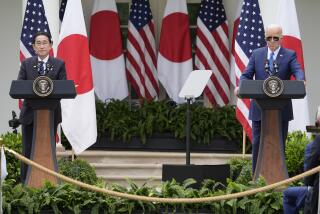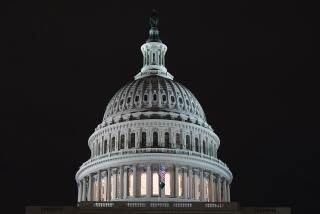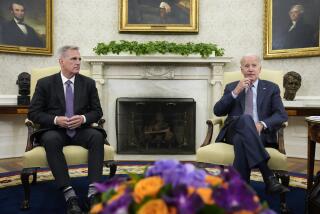Japan Bows to U.S., Lowers Its Discount Rate
- Share via
WASHINGTON — Japan and the United States arrived at a far-reaching economic accord Friday that includes actions to promote trade, stimulate the Japanese economy and possibly reverse the dollar’s year-long decline against the yen, Treasury officials said.
The unusual agreement stems from a meeting between Treasury Secretary James A. Baker III and Japanese Finance Minister Kiichi Miyazawa in San Francisco early last month, according to a senior Treasury official who requested anonymity.
A key element of the accord is a decision by the Bank of Japan to cut its discount lending rate to a postwar low of 3% from 3.5%, a move that Washington has long sought.
The stimulative action is intended to promote growth in Japan--and the demand for imports--but could have the effect of weakening the yen against the dollar by reducing the return on bonds and other investment vehicles.
The Japanese have also agreed to submit a 3.6 trillion yen supplementary budget to the Diet (their parliament) designed to boost growth through substantial investment in housing, public works and non-residential construction.
A third element of the accord calls for a program to push tax reform through the Diet. A Government Tax Council report recommends reducing the effective corporate tax rate to below 50%. It also calls for an unspecified reduction in the marginal tax rate on personal income.
In return, Washington has promised to continue reducing the U.S. budget deficit, continue to fight protectionist pressure and implement tax reforms recently passed by Congress. The official denied that the agreement was one-sided, saying the U.S. reforms were “highly significant” and appreciated by the Japanese.
In reference to possible yen-dollar realignment, the official refused to say explicitly that the Reagan Administration believes the dollar has fallen far enough against the yen or that any correction is desirable.
“The realignment which has occurred between the yen and the dollar broadly reflects the present fundamentals,” he said.
More to Read
Sign up for Essential California
The most important California stories and recommendations in your inbox every morning.
You may occasionally receive promotional content from the Los Angeles Times.










